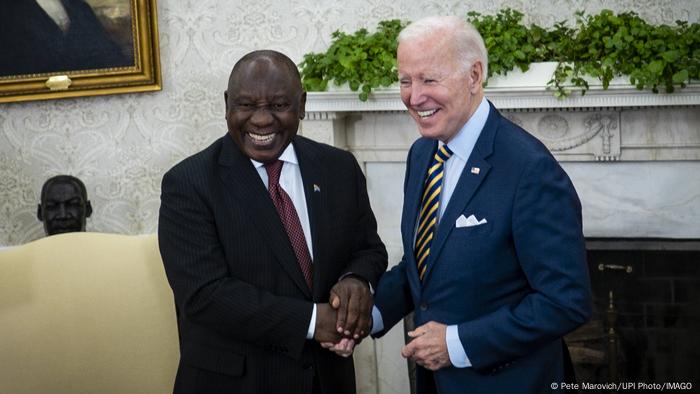Analyzing Ramaphosa's White House Encounter: Could He Have Handled It Differently?

Table of Contents
Assessing Ramaphosa's Diplomatic Strategy
Pre-meeting Preparations and Expectations
The Ramaphosa White House visit followed months of anticipation and strategic preparation. The overarching goals were multifaceted, aiming to bolster South Africa's international standing and strengthen bilateral ties with a major global power. Public perception placed significant emphasis on tangible outcomes, particularly in key areas:
- Strengthening economic ties: Increasing trade and investment between the two nations was a primary objective.
- Addressing trade imbalances: Reducing the trade deficit and promoting fairer trade practices were crucial aspects of the agenda.
- Securing US investment: Attracting significant US investment into South Africa's economy was a key aspiration.
- Climate change collaboration: Discussions around collaborative efforts to combat climate change were expected.
- Strengthening security cooperation: Addressing shared security concerns, particularly regarding terrorism and transnational crime, was also on the table.
Ramaphosa's Communication Style and Body Language
Analyzing Ramaphosa's communication style during the encounter is crucial. His verbal and non-verbal cues played a significant role in shaping the overall perception of the meeting. While precise interpretations vary, some observers noted a measured and diplomatic approach, prioritizing consensus-building. Others felt his communication lacked the assertiveness needed to fully advance South Africa's interests. Further detailed analysis is required to fully assess the impact of his communication style.
- Examples of communication styles: Ramaphosa employed a largely conciliatory tone, emphasizing areas of mutual agreement.
- Use of specific language: His carefully chosen words reflected a commitment to diplomacy and de-escalation.
- Body language interpretations: While largely composed, some interpreted his body language as suggestive of a defensive posture in certain key moments.
Addressing Key Policy Differences
Significant policy differences between the two nations, notably regarding the Russia-Ukraine conflict and South Africa's relationships with China, inevitably arose. Ramaphosa's approach to these sensitive issues was crucial. He attempted to balance South Africa's non-aligned stance with the need to maintain strong relations with the US. However, critics argue that this approach may have been perceived as insufficiently assertive by the US administration.
- Specific policy disagreements: The differing perspectives on the war in Ukraine and South Africa's economic ties with China were significant points of contention.
- Ramaphosa's responses: He largely focused on highlighting South Africa's commitment to peace and multilateralism.
- Potential alternative approaches: A more proactive engagement on specific concerns, perhaps coupled with private diplomacy, might have yielded more fruitful results.
Alternative Approaches and Potential Outcomes
A More Assertive Diplomatic Strategy
A more assertive diplomatic strategy could have involved a more direct and forceful articulation of South Africa's interests. While this carries risks, it might have resulted in more concrete commitments from the US administration.
- Specific examples of more assertive communication: Clearly stating South Africa's position on the Russia-Ukraine conflict and defending its relationship with China more forcefully.
- Potential positive outcomes: Securing more substantial economic concessions or greater support for South Africa's developmental goals.
- Potential risks and downsides: The risk of straining the relationship and jeopardizing future cooperation.
Prioritizing Specific Areas of Cooperation
Focusing on areas of common ground, such as climate change collaboration, trade in specific sectors, or health initiatives, could have laid a stronger foundation for broader cooperation. Building trust and momentum in areas of agreement would then open avenues for more productive discussions on contentious issues.
- Identifying key areas of cooperation: Concentrating on shared interests, such as tackling climate change or fostering innovation, allows for building consensus.
- Building consensus: This approach could have created a more positive atmosphere for negotiations on more challenging aspects of the bilateral relationship.
- Sequencing negotiation priorities: Prioritizing areas of agreement strategically allows for a more measured approach to addressing areas of disagreement.
Leveraging Public Diplomacy and Media Engagement
Strategic media engagement before, during, and after the Ramaphosa White House visit could have been used to frame the narrative and manage public perceptions. A proactive public diplomacy approach could have strengthened South Africa's messaging and counteracted potential negative narratives.
- Pre-meeting media strategy: Proactive communication highlighting the importance of the meeting and the shared interests could have improved public perception.
- Managing post-meeting narrative: A coherent and timely communication plan after the encounter could have shaped the interpretation of the events.
- Strategic communication with target audiences: Tailoring messages for specific audiences (e.g., business leaders, the general public, policymakers) would have strengthened engagement.
The Broader Context of South Africa-US Relations
Historical Relations and Current Challenges
South Africa and the US share a complex history. From apartheid-era sanctions to post-apartheid cooperation, the relationship has been marked by both tension and collaboration. Current challenges include differing views on global issues and economic competition.
- Key historical moments: The imposition of sanctions during apartheid, the transition to democracy, and subsequent cooperation on various initiatives mark the history.
- Current challenges in the relationship: Trade imbalances, divergent viewpoints on global governance, and geopolitical competition remain key challenges.
Impact on South African Domestic Politics
The outcome of the Ramaphosa White House visit has had significant ramifications for domestic South African politics. Public perception of the meeting and its outcomes directly impacts Ramaphosa's standing and his government's policy agenda.
- Public reaction in South Africa: The public response has been varied, with some expressing satisfaction and others disappointment.
- Political implications: The success or failure of the visit has influenced domestic political discourse and debates about foreign policy.
- Impact on economic policy: The outcomes of the meeting can affect investment flows, trade agreements, and overall economic strategies.
Conclusion: Re-examining Ramaphosa's White House Encounter
This analysis of the Ramaphosa White House visit highlights the complexities of high-level diplomatic interactions. Ramaphosa's diplomatic strategy, while aiming for consensus, might have benefitted from a more assertive articulation of South African interests in specific areas. Alternative approaches, such as prioritizing areas of cooperation and leveraging public diplomacy more effectively, could yield more fruitful outcomes in the future. Understanding these nuances is critical to fostering stronger South Africa US relations. The lasting impact of this meeting on the bilateral relationship remains to be seen, but a careful review of the strategies employed is crucial for future engagements. We encourage you to share your perspectives on the Ramaphosa White House visit and contribute to the ongoing discussion on effective diplomatic strategies in international relations. Let's continue the conversation about optimizing approaches to the South Africa US relations through effective diplomatic strategies.

Featured Posts
-
 Smart Memorial Day Travel Best Days To Fly In 2025
May 24, 2025
Smart Memorial Day Travel Best Days To Fly In 2025
May 24, 2025 -
 Sunday May 11 Nyt Mini Crossword Complete Guide To Hints And Answers
May 24, 2025
Sunday May 11 Nyt Mini Crossword Complete Guide To Hints And Answers
May 24, 2025 -
 Relx Doorstaat Economische Zwakte Dankzij Ai Sterke Groei Voorspeld Tot 2025
May 24, 2025
Relx Doorstaat Economische Zwakte Dankzij Ai Sterke Groei Voorspeld Tot 2025
May 24, 2025 -
 Character Ai Chatbots And Free Speech A Legal Gray Area
May 24, 2025
Character Ai Chatbots And Free Speech A Legal Gray Area
May 24, 2025 -
 Nyt Mini Crossword Today Hints And Answers For March 6 2025
May 24, 2025
Nyt Mini Crossword Today Hints And Answers For March 6 2025
May 24, 2025
